Response of Sap Flow Trends of Conifer and Broad-Leaved Trees to Rainfall Types in Sub-Humid Climate Region of China
Abstract
1. Introduction
2. Materials and Methods
2.1. Study Site Description
2.2. Sap Flow Measurements
2.3. Soil Water and Meteorological Factor Measurements
2.4. Cluster Analysis of Rainfall Events
2.5. Data Analysis
3. Results
3.1. Precipitation Characteristics and Meteorological Factors
3.2. Daily Sap Flow Characteristics within Three Rainfall Types
3.3. Hourly Sap Flow Characteristics within Three Rainfall Types
4. Discussion
4.1. Response of Sap Flow Characteristics to Other Factors under Three Rainfall Types at the Daily Scale
4.2. Response of Sap Flow Characteristics to Other Factors under Three Rainfall Types at the Hourly Scale
4.3. The Difference in Sap Flow Characteristics between Conifer and Broad-Leaved Species under Three Rainfall Types
5. Conclusions
Author Contributions
Funding
Data Availability Statement
Conflicts of Interest
References
- Nadezhdina, N. Sap flow index as an indicator of plant water status. Tree Physiol. 1999, 19, 885. [Google Scholar] [CrossRef] [PubMed]
- Kray, J.A.; Cooper, D.J.; Sanderson, J.S. Groundwater use by native plants in response to changes in precipitation in an intermountain basin. J. Arid. Environ. 2012, 83, 25–34. [Google Scholar] [CrossRef]
- Liu, H.; Yin, Y.; Wang, Q.; He, S. Climatic effects on plant species distribution within the forest–steppe ecotone in northern China. Appl. Veg. Sci. 2015, 18, 43–49. [Google Scholar] [CrossRef]
- Tao, Z.; Wang, H.; Liu, Y.; Xu, Y.; Dai, J. Phenological response of different vegetation types to temperature and precipitation variations in northern China during 1982–2012. Int. J. Remote Sens. 2017, 38, 3236–3252. [Google Scholar] [CrossRef]
- Macias, F.M. Satellite images show China going green. Nature 2018, 553, 411–413. [Google Scholar] [CrossRef] [PubMed]
- Zhang, M.F.; Wei, X.H. Deforestation, forestation and water supply. Science 2021, 371, 990–991. [Google Scholar] [CrossRef] [PubMed]
- Kathy, S.; De, P.; Raoul, L.; Vanrolleghem, P.A. A mathematical model linking tree sap flow dynamics to daily stem diameter fluctuations and radial stem growth. Tree Physiol. 2006, 26, 257. [Google Scholar]
- Jia, G.; Liu, Z.; Chen, L.; Yu, X. Distinguish water utilization strategies of trees growing on earth-rocky mountainous area with transpiration and water isotopes. Ecol. Evol. 2017, 7, 10640–10651. [Google Scholar] [CrossRef]
- Jian, S.; Zhang, X.; Wu, Z. Water use pattern of Pinus tabulaeformis in the semiarid region of Loess Plateau, China. For. Syst. 2016, 25, 077–084. [Google Scholar] [CrossRef]
- Li, M.; Xia, J.; Chen, Z.; Meng, D.; Xu, C. Variation analysis of precipitation during past 286 years in Beijing area, china, using non-parametric test and wavelet analysis. Hydrol. Process. 2013, 27, 2934–2943. [Google Scholar] [CrossRef]
- Liu, J.; Bloomberg, M.; Li, G.; Liu, Y. Effects of copper root pruning and radicle pruning on first-season field growth and nutrient status of Chinese cork oak seedlings. New For. 2016, 47, 715–729. [Google Scholar] [CrossRef]
- Graham, E.A.; Mulkey, S.S.; Kitajima, K.; Phillips, N.G.; Wright, S.J. Cloud cover limits net CO2 uptake and growth of a rainfallforest tree during tropical rainfally seasons. Proc. Natl. Acad. Sci. USA 2018, 100, 2. [Google Scholar]
- Zhao, C.; Si, J.; Feng, Q.; Yu, T.; Li, W. Stem Sap Flow Research: Progress and Prospect. J. Northwest For. Univ. 2015, 30, 98–105. [Google Scholar]
- Seneviratne, S.I.; Lüthi, D.; Litschi, M.; Schär, C. Land-atmosphere coupling and climate change in Europe. Nature 2006, 443, 7108. [Google Scholar] [CrossRef] [PubMed]
- Shi, P.; Sun, X.; Wang, M.; Li, N.; Wang, J.; Jin, Y.; Yin, W. Climate change regionalization in China (1961–2010). Sci. China Earth Sci. 2014, 44, 2294–2306. [Google Scholar] [CrossRef]
- Nie, Y.P.; Chen, H.S.; Wang, K.L.; Tan, W.; Deng, P.Y.; Yang, J. Seasonal water use patterns of woody species growing on the continuous dolostone outcropsand nearby thin soils in subtropical China. Plant Soil 2011, 341, 399–412. [Google Scholar] [CrossRef]
- Ren, G.; Ren, Y.; Zhan, Y.; Sun, X.; Liu, Y.; Chen, Y.; Wang, T. Spatial and temporal patterns of precipitation variability over mainland China: II: Recent trends. Adv. Water Sci. 2015, 26, 451–465. [Google Scholar]
- Chen, S.; Fu, Y.H.; Geng, X.; Hao, Z.; Tang, J.; Zhang, X.; Xu, Z.; Hao, F. Influences of shifted vegetation phenology on runoff across a hydroclimatic gradient. Front. Plant Sci. 2022, 12, 802664. [Google Scholar] [CrossRef]
- D’Odorico, P.; Caylor, K.; Okin, G.S.; Scanlon, T.M. On soil moisture-vegetation feedbacks and their possible effects on the dynamics of dryland ecosystems. J. Geophys. Res. Biogeosci. 2015, 112, G04010. [Google Scholar] [CrossRef]
- Liu, X.; Zhang, Y.; Xiao, T. Runoff velocity controls soil nitrogen leaching in subtropical restored forest in Southern China. For. Ecol. Manag. 2023, 548, 121412. [Google Scholar] [CrossRef]
- Liu, X.; Zhang, Y.; Zhang, L. Aggregate-associated soil organic carbon fractions in subtropical soil undergoing vegetative restoration. Land. Degrad. Dev. 2023, 34, 4296–4306. [Google Scholar] [CrossRef]
- Zhang, X.L.; Lv, P.C.; Xu, C.; Huang, X.R.; Rademacher, T. Dryness decreases average growth rate and increases drought sensitivity of Mongolia oak trees in north China. Agric. For. Meteorol. 2021, 308, 108611. [Google Scholar] [CrossRef]
- Ziv, A.; Jean-Christophe, D.; Ram, O.; Way, D.A.; Menachem, M. Growth and physiological responses of isohydric and anisohydric poplars to drought. J. Exp. Bot. 2015, 14, 4373–4381. [Google Scholar]
- Tyree, M.T. A dynamic model for water flow in a single tree: Evidence that models must account for hydraulic architecture. Tree Physiol. 1988, 4, 195–217. [Google Scholar] [CrossRef]
- Schaeffer, S.M.; Williams, D.G.; Goodrich, D.C. Transpiration of cottonwood/willow forest estimated from sap flux. Agric. For. Meteorol. 2000, 105, 257–270. [Google Scholar] [CrossRef]
- Bosch, D.D.; Marshall, L.K.; Teskey, R. Forest transpiration from sap flux density measurements in a Southeastern Coastal Plain riparian buffer system. Agric. For. Meteorol. 2014, 187, 72–82. [Google Scholar] [CrossRef]
- Angadi, S.V.; Entz, M.H. Root system and water use patterns of different height sunflower cultivars. Agron. J. 2002, 94, 136–145. [Google Scholar] [CrossRef]
- Wu, H.W.; Li, X.Y.; Jiang, Z.Y.; Chen, H.Y.; Zhang, C.C.; Xiao, X. Contrasting water use pattern of introduced and native plants in an alpine desert ecosystem, northeast Qinghai–tibet plateau, China. Sci. Total Environ. 2016, 542, 182–191. [Google Scholar] [CrossRef]
- Wang, D.; Gao, G.; Li, J.; Yuan, C.; Lü, Y.; Fu, B. Sap flow dynamics of xerophytic shrubs differ significantly among rainfall types in the Loess Plateau of China. J. Hydrol. 2020, 585, 124815. [Google Scholar] [CrossRef]
- Johnson, D.M.; McCulloh, K.A.; Woodruff, D.R.; Meinzer, F.C. Hydraulic safety margins and embolism reversal in stems and leaves: Why are conifers and angiosperms so different? Plant Sci. 2012, 195, 48–53. [Google Scholar] [CrossRef]
- Jia, G.; Yu, X.; Deng, W. Seasonal water use patterns of semi-arid plants in China. For. Chron. 2013, 89, 169–177. [Google Scholar] [CrossRef][Green Version]
- Li, B.F.; Chen, Y.N.; Shi, X.; Chen, Z.S.; Li, W.H. Temperature and precipitation changes in different environments in the arid region of northwest China. Theor. Appl. Climatol. 2013, 112, 589–596. [Google Scholar] [CrossRef]
- Huang, L.; Zhang, Z. Effect of rainfall pulses on plant growth and transpiration of two xerophytic shrubs in a revegetated desert area: Tengger Desert, China. Catena 2012, 137, 269–276. [Google Scholar] [CrossRef]
- Chen, D.; Wang, Y.; Liu, S.; Wei, X.; Wang, X. Response of relative sap flow to meteorological factors under different soil moisture conditions in rainfallfed jujube (Ziziphus jujuba Mill.) plantations in semiarid Northwest China. Agric. Water Manag. 2014, 136, 23–33. [Google Scholar] [CrossRef]
- Huxman, T.E.; Snyder, K.A.; Tissue, D.; Leffler, A.J.; Schwinning, S. Precipitation pulses and carbon fluxes in semiarid and arid ecosystems. Oecologia 2004, 141, 254–268. [Google Scholar] [CrossRef] [PubMed]
- David, T.S.; Pinto, C.A.; Nadezhdina, N.; Kurz-Besson, C.; Henriques, M.O.; Quilhó, T.; Cermak, J.; Chaves, M.M.; Pereira, J.S. Root functioning, treewater use and hydraulic redistribution in Quercus suber trees: A modelingapproach based on root sap flow. For. Ecol. Manag. 2013, 307, 136–146. [Google Scholar] [CrossRef]
- Liu, Z.; Yu, X.; Jia, G. Contrasting water sources of evergreen and deciduous tree species in rocky mountain area of Beijing, China. Catena 2017, 150, 108–115. [Google Scholar] [CrossRef]
- Granier, A.; Huc, R.; Barigah, S.T. Transpiration of natural rainfall forest and its dependence on climatic factors. Agric. For. Meteorol. 1996, 78, 19–29. [Google Scholar] [CrossRef]
- Jia, J.; Yu, X.; Li, Y. Response of forestland soil water content to heavy rain pattern in Beijing Mountain, northern China. J. For. Res. 2016, 27, 541–550. [Google Scholar] [CrossRef]
- Zhang, Y.; Yang, M.; Pan, X.; Song, L.; Yu, L. Influence of Rainfall Division Method on Capture Ratio of Rainfall. China Water Wastewater 2019, 35, 122–127. [Google Scholar]
- Liu, Z.; Ye, L.; Jiang, J.; Liu, R.; Xu, Y.; Jia, G. Increased uptake of deep soil water promotes drought resistance in mixed forests. Plant Cell Environ. 2023, 46, 3218–3228. [Google Scholar] [CrossRef] [PubMed]
- Szutu, D.J.; Papuga, S.A. Year-round transpiration dynamics linked with deep soil moisture in a warm desert shrubland. Water Resour. Res. 2019, 55, 7. [Google Scholar] [CrossRef]
- Kume, T.; Kuraji, K.; Yoshifuji, N.; Morooka, T.; Sawano, S.; Chong, L. Estimation of canopy drying time after rainfall using sap flow measurements in an emergent tree in a lowland mixed-dipterocarp forest in Sarawak, Malaysia. Hydrol. Process. 2006, 20, 565–578. [Google Scholar] [CrossRef]
- Yue, G.; Zhao, H.; Zhang, T.; Zhao, X.; Niu, L.; Sam, D. Evaluation of water use of Caragana microphylla with the stem heat-balance method in Horqin Sandy Land, Inner Mongolia, China. Agric. For. Meteorol. 2008, 148, 11. [Google Scholar] [CrossRef]
- Wen, X.; Zhang, S.; Sun, X. Water vapor and precipitation isotope ratios in Beijing. J. Geophys. Res. 2010, 115, 133–134. [Google Scholar] [CrossRef]
- Yuan, C.; Gao, G.; Fu, B. Comparisons of stem flow and its bio-/abiotic influential factors between two xerophytic shrub species. Hydrol. Earth Syst. Sci. 2017, 21, 3. [Google Scholar] [CrossRef]

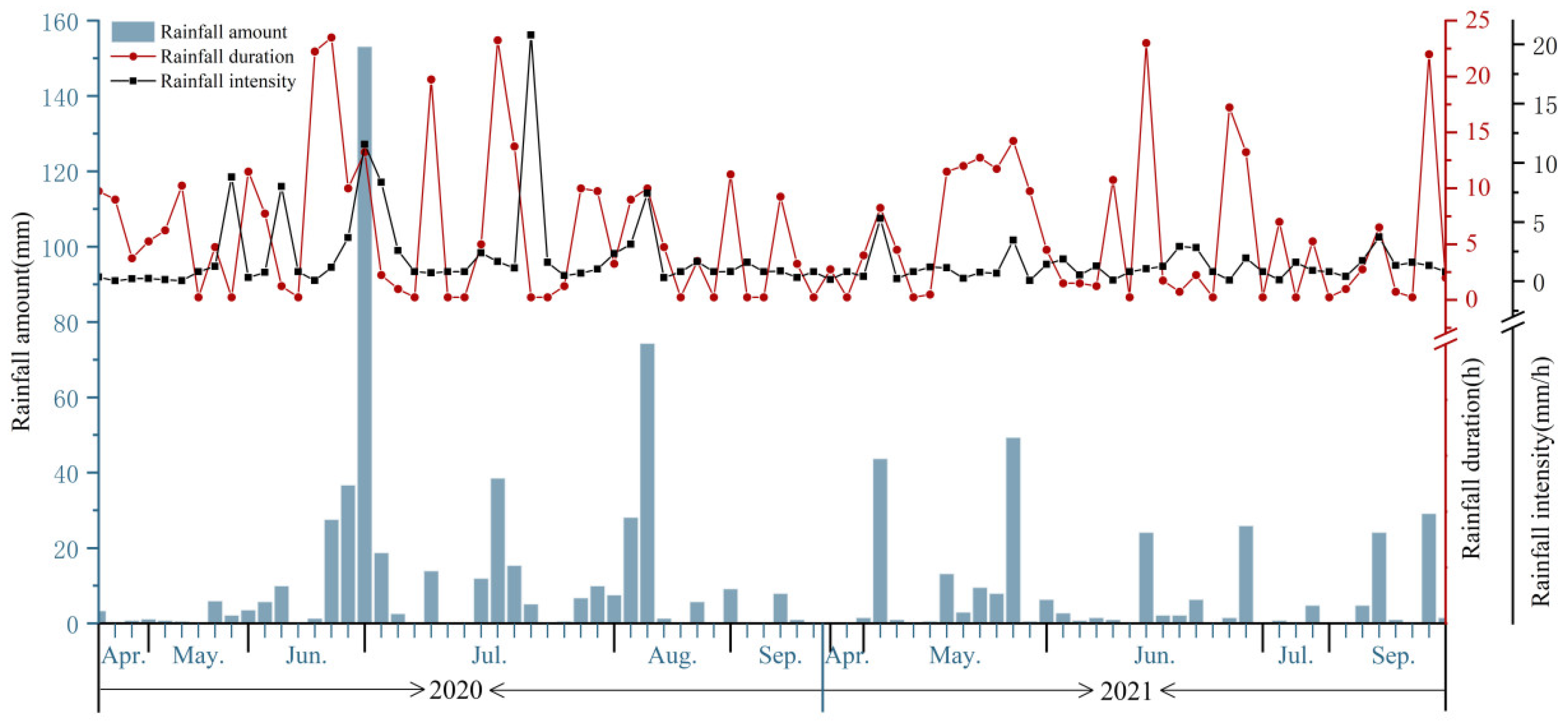
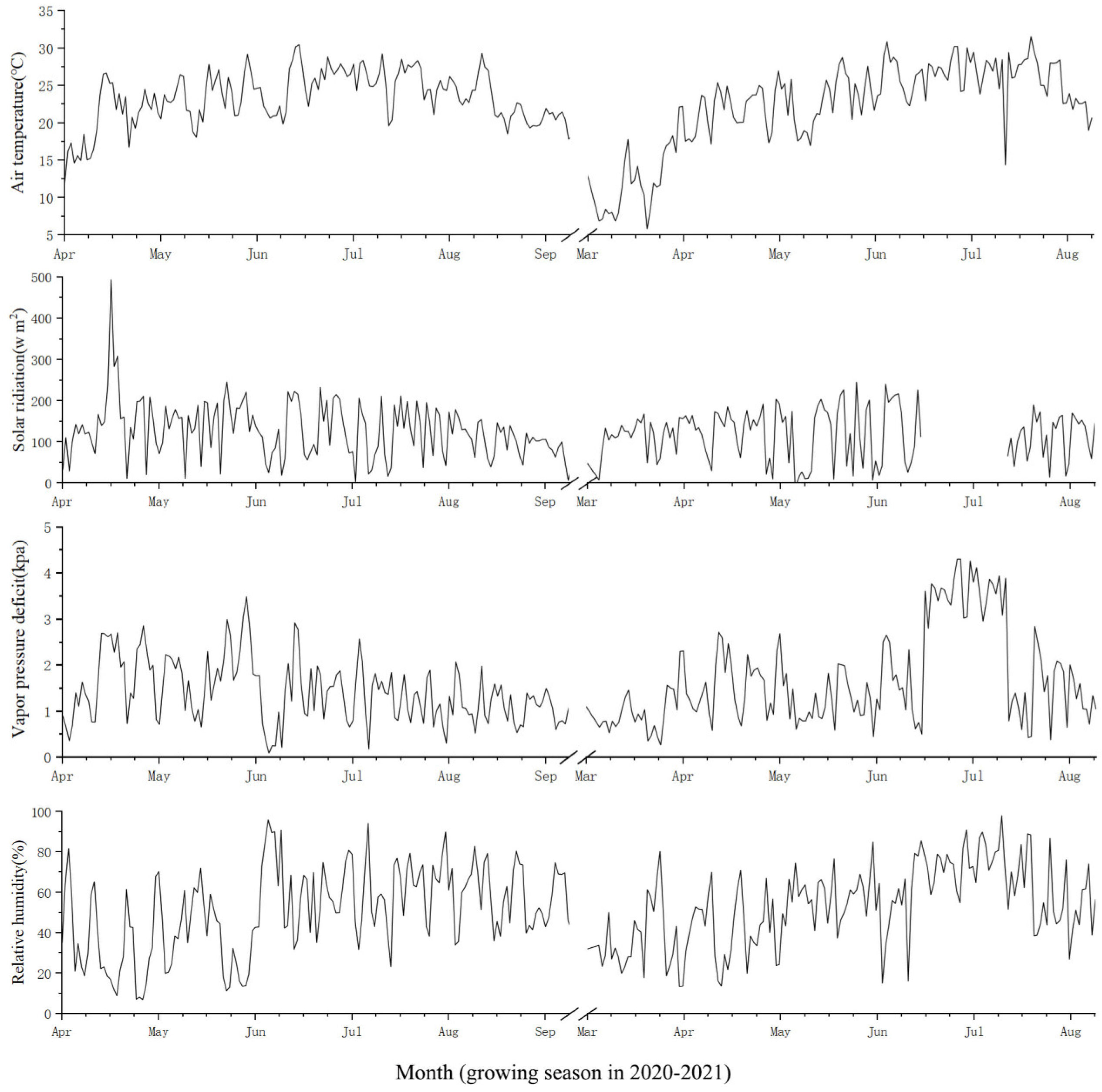
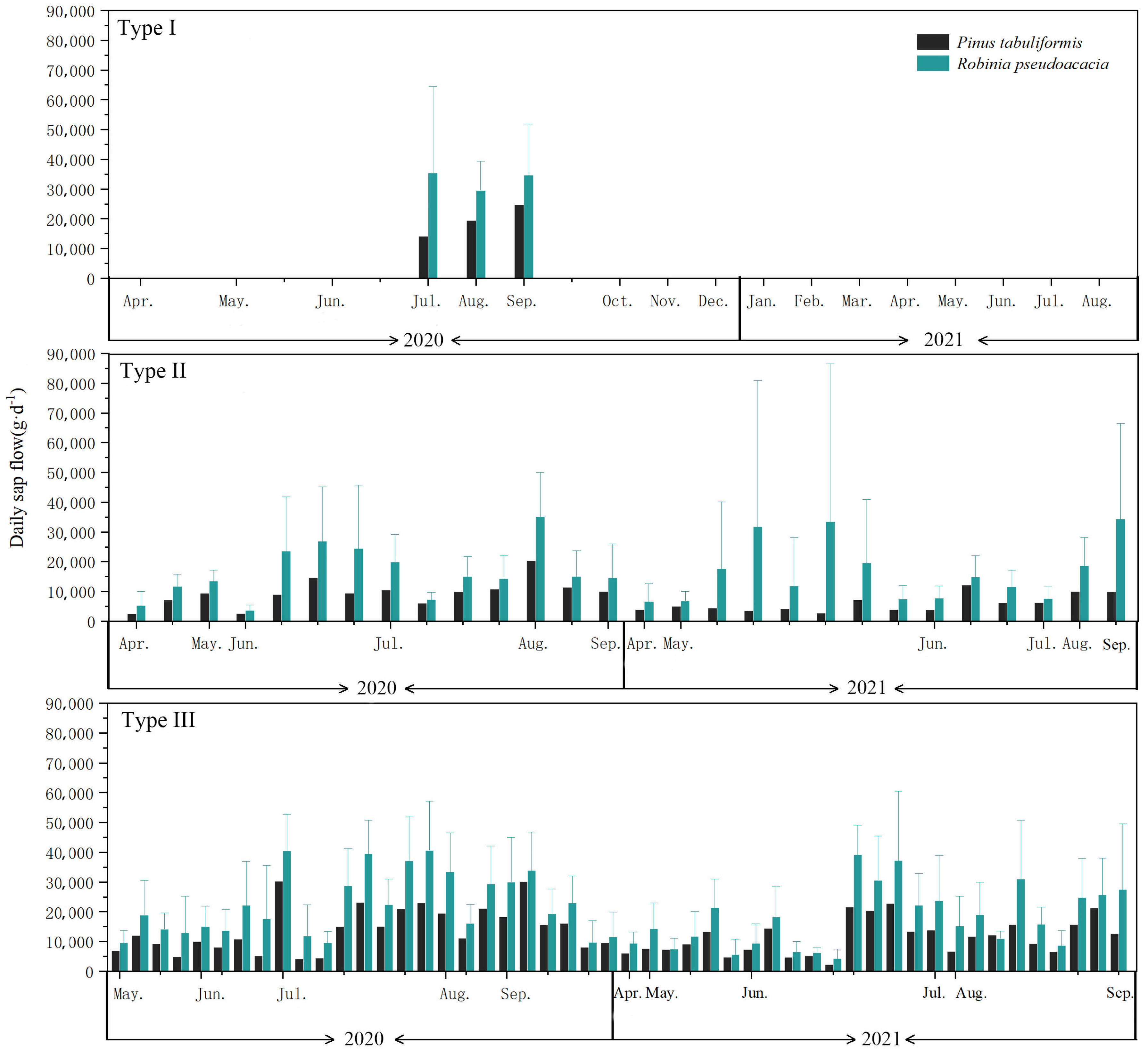
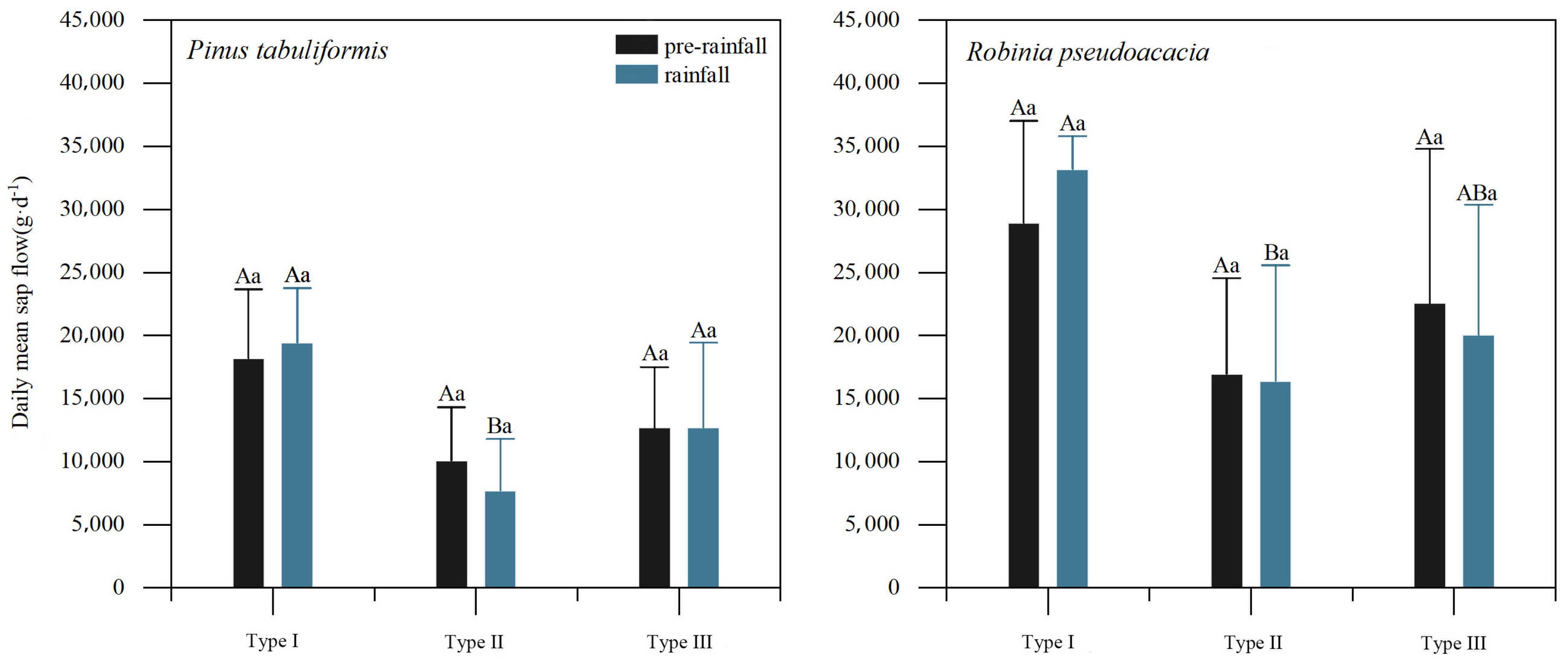
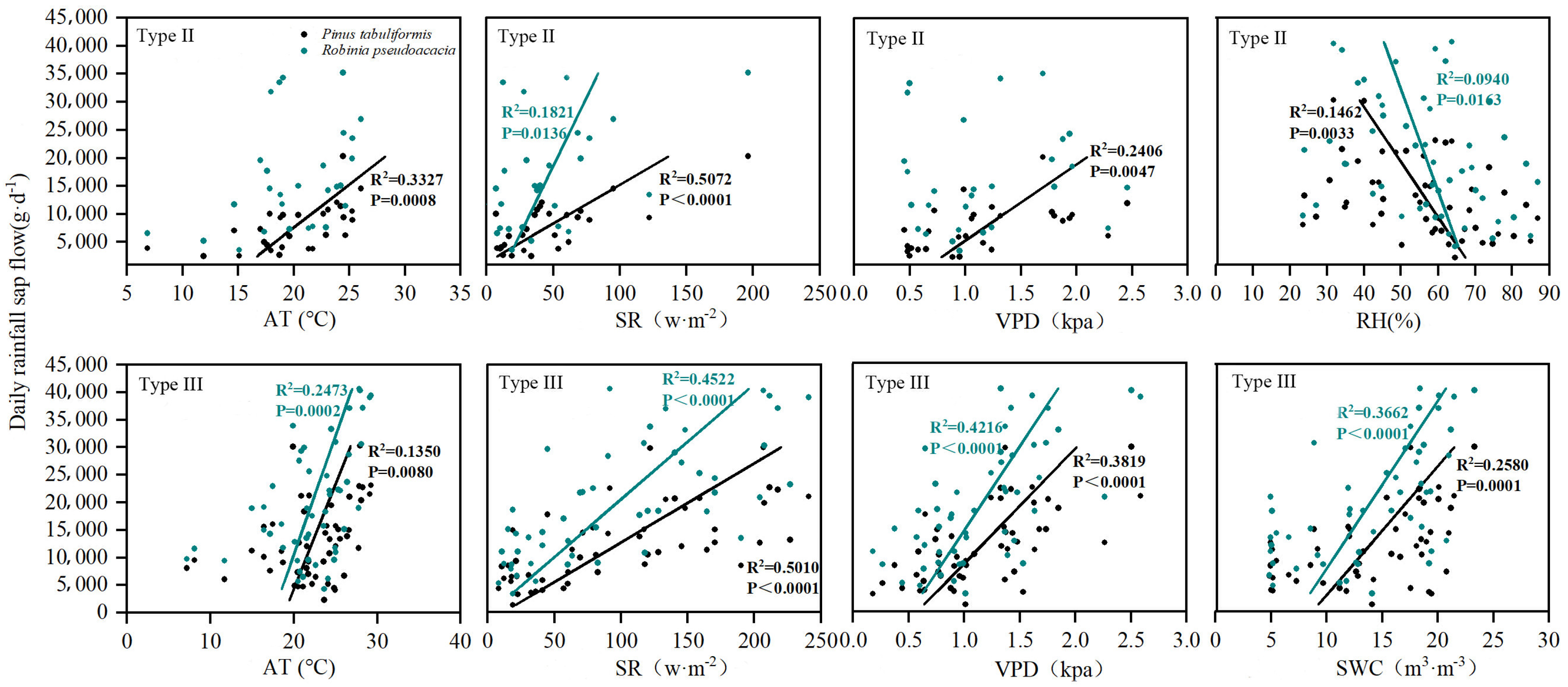

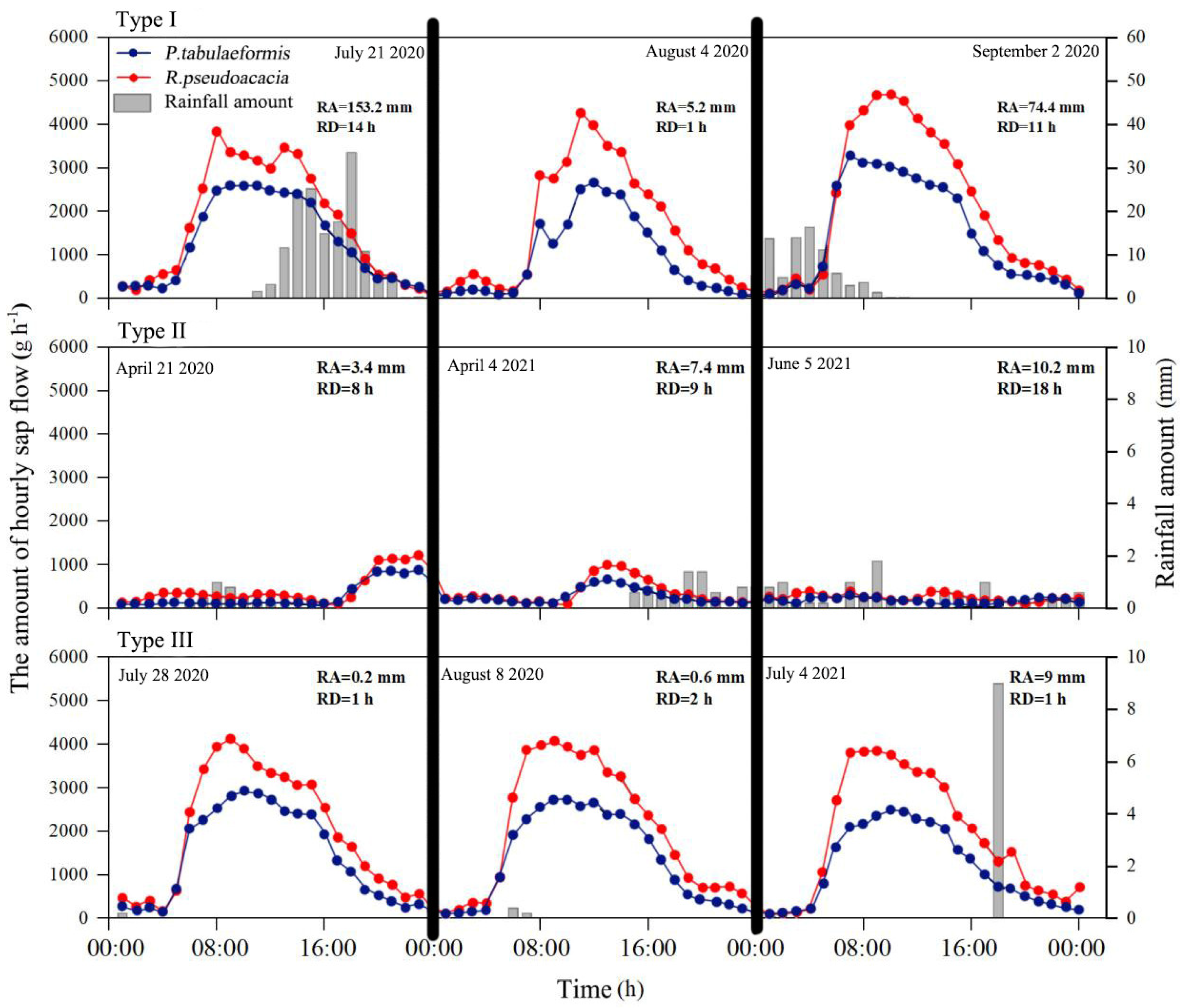
| Species Stand | Density/(Tree/hm2) | Average Age/a | Indices | Standard Sample Trees | ||
|---|---|---|---|---|---|---|
| No.1 | No.2 | No.3 | ||||
| P. tabuliformis stand | 1200 | 25 | Height/m | 8.5 | 5.3 | 6.2 |
| diameter/cm | 18.47 | 16.57 | 13.06 | |||
| R. pseudoacacia stand | 900 | 43 | Height/m | 9.6 | 9.1 | 9.4 |
| diameter/cm | 23.89 | 17.83 | 14.65 | |||
| Rainfall Types | Frequency | Rainfall Characteristic | Mean ± Standard Deviation | Variation Coefficient (%) |
|---|---|---|---|---|
| Type Ⅰ | 3 (3.67%) | Rainfall amount/mm | 77.60 ± 74.10 | 95.43 |
| Rainfall duration/h | 7.83 ± 6.77 | 86.37 | ||
| Rainfall intensity/mm h−1 | 13.27 ± 6.84 | 51.56 | ||
| Type Ⅱ | 28 (34.15%) | Rainfall amount/mm | 15.64 ± 14.55 | 93.03 |
| Rainfall duration/h | 13.40 ± 5.19 | 38.71 | ||
| Rainfall intensity/mm h−1 | 1.27 ± 1.37 | 107.35 | ||
| Type Ⅲ | 51 (62.20%) | Rainfall amount/mm | 2.37 ± 3.60 | 152.40 |
| Rainfall duration/h | 2.00 ± 2.09 | 104.25 | ||
| Rainfall intensity/mm h−1 | 1.48 ± 1.88 | 126.60 |
| Rainfall Types | Ta (°C) | Rn (w·m−2) | RH (%) | VPD (kpa) |
|---|---|---|---|---|
| Type Ⅰ | 23.65 ± 3.76 a | 94.30 ± 106.80 a | 49.53 ± 15.91 a | 1.51 ± 0.20 a |
| Type Ⅱ | 20.05 ± 4.49 a | 45.71 ± 41.31 ab | 50.96 ± 19.49 a | 1.19 ± 0.60 a |
| Type Ⅲ | 22.20 ± 4.84 a | 95.31 ± 70.99 b | 56.65 ± 17.08 a | 1.17 ± 0.54 a |
| Species | Rainfall Types | T | SR | RH | VPD | SWC |
|---|---|---|---|---|---|---|
| P.tabuliformis | Type Ⅱ | 0.60 ** | 0.73 ** | −0.25 | 0.52 ** | 0.31 |
| Type ⅡI | 0.37 ** | 0.68 ** | −0.41 ** | 0.63 ** | 0.52 ** | |
| R.pseudoacacia | Type Ⅱ | 0.37 | 0.46 * | 0.17 | 0.09 | 0.15 |
| Type ⅡI | 0.50 ** | 0.72 ** | −0.34 * | 0.66 ** | 0.62 ** |
Disclaimer/Publisher’s Note: The statements, opinions and data contained in all publications are solely those of the individual author(s) and contributor(s) and not of MDPI and/or the editor(s). MDPI and/or the editor(s) disclaim responsibility for any injury to people or property resulting from any ideas, methods, instructions or products referred to in the content. |
© 2023 by the authors. Licensee MDPI, Basel, Switzerland. This article is an open access article distributed under the terms and conditions of the Creative Commons Attribution (CC BY) license (https://creativecommons.org/licenses/by/4.0/).
Share and Cite
Cao, Y.; Wang, Y.; Zhang, N.; Ning, C.; Bai, Y.; Jia, J. Response of Sap Flow Trends of Conifer and Broad-Leaved Trees to Rainfall Types in Sub-Humid Climate Region of China. Water 2024, 16, 95. https://doi.org/10.3390/w16010095
Cao Y, Wang Y, Zhang N, Ning C, Bai Y, Jia J. Response of Sap Flow Trends of Conifer and Broad-Leaved Trees to Rainfall Types in Sub-Humid Climate Region of China. Water. 2024; 16(1):95. https://doi.org/10.3390/w16010095
Chicago/Turabian StyleCao, Yongxiang, Yushi Wang, Naichang Zhang, Chendong Ning, Yu Bai, and Jianbo Jia. 2024. "Response of Sap Flow Trends of Conifer and Broad-Leaved Trees to Rainfall Types in Sub-Humid Climate Region of China" Water 16, no. 1: 95. https://doi.org/10.3390/w16010095
APA StyleCao, Y., Wang, Y., Zhang, N., Ning, C., Bai, Y., & Jia, J. (2024). Response of Sap Flow Trends of Conifer and Broad-Leaved Trees to Rainfall Types in Sub-Humid Climate Region of China. Water, 16(1), 95. https://doi.org/10.3390/w16010095






